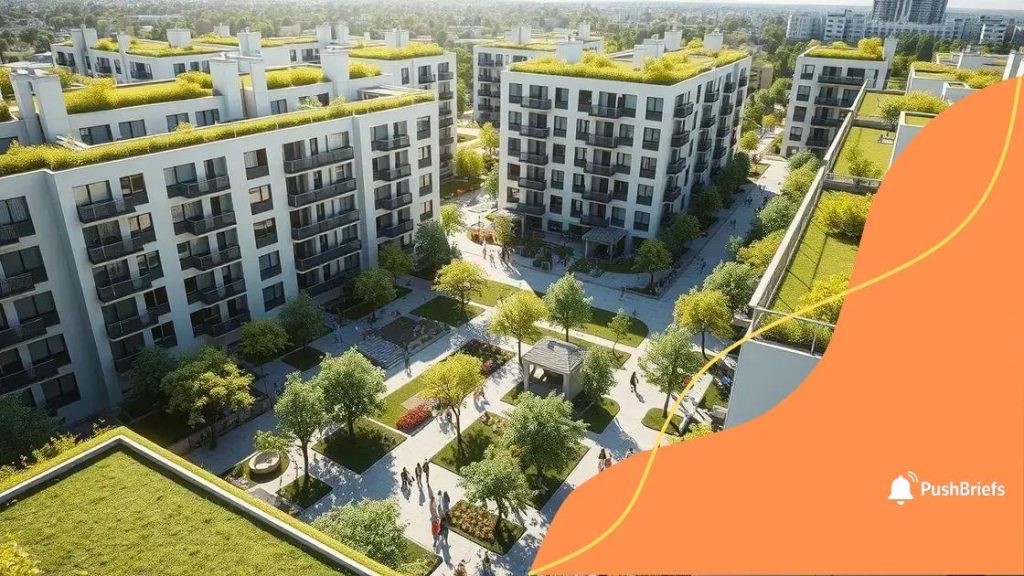Social housing update: what’s new in affordable living?

Future trends in affordable housing initiatives focus on sustainability, technology integration, community involvement, and innovative policies to create livable and equitable environments for all residents.
Social housing update brings some exciting news that could change how we think about affordable living. Have you noticed the shifts in your neighborhood? Let’s dive into what’s new and how it affects you.
Understanding the current state of social housing
Understanding the current state of social housing is essential for grasping how communities grow and thrive. Land availability and economic factors shape this landscape.
Key Features of Social Housing
Social housing is not one-size-fits-all; it varies widely. Different areas have unique requirements, which affect how housing is developed. Here are some important aspects:
- Affordability: Social housing aims to provide homes that are affordable for low-income families.
- Accessibility: Many projects focus on making housing accessible for people with disabilities.
- Sustainability: Green building practices are becoming crucial in new developments.
In recent years, the demand for social housing has surged due to rising property prices and changing demographics. The current state reflects a growing acknowledgment of housing as a basic human right. It’s vital to ensure that everyone has access to quality living conditions.
Current Challenges
Despite these advancements, social housing faces many challenges. Funding constraints and bureaucratic delays often impede projects. Furthermore, community opposition can arise, complicating development.
Understanding local needs is also paramount. Not all communities share the same requirements for housing types. Engaging with community members leads to better outcomes in design and placement of social housing.
Future Directions
As we look ahead, innovative solutions are emerging. Some regions are experimenting with mixed-income communities, which integrate social housing with market-rate options. This approach can foster inclusivity and reduce stigma around social housing.
Collaboration between government, developers, and nonprofit organizations is essential. By working together, these entities can create sustainable, affordable housing solutions for future generations.
Recent changes in social housing policies
Recent changes in social housing policies reflect a growing focus on making housing more accessible for everyone. This shift recognizes the need to adapt to current economic and social challenges.
New Initiatives
Several governments are introducing initiatives designed to improve social housing options. These initiatives take various forms, such as:
- Increased funding: More resources are being allocated to build and maintain affordable housing.
- Streamlined processes: Simplifying the application process for housing assistance helps more families gain access.
- Collaboration: Partnerships with private developers aim to expand the availability of social housing.
These changes are essential for addressing the growing housing crisis, especially in urban areas where demand far exceeds supply. More families are finding it challenging to secure stable housing due to rising costs and limited availability.
Impact on Communities
As policies evolve, the impact on communities can be significant. Community participation is increasingly encouraged to identify local needs better. This collaboration can lead to improved living conditions and enhanced community ties.
Building new developments is beneficial, but it’s equally crucial to ensure existing housing remains in good condition. Policies are being crafted to support not just new construction but also the upgrade and maintenance of current social housing.
Future Outlook
Looking ahead, there’s a focus on sustainable practices in social housing development. Policymakers aim to incorporate eco-friendly designs into new projects, which can save energy and reduce costs for residents in the long run.
With ongoing changes, it’s vital that policies remain flexible and responsive to community needs. The evolution of social housing policies will likely continue as society recognizes the critical role that stable housing plays in overall health and prosperity.
Impact of social housing on local communities

The impact of social housing on local communities is profound and multifaceted. When social housing is developed, it often leads to improved quality of life for residents and transforms the neighborhood.
Economic Benefits
One significant impact is economic revitalization. Social housing projects can stimulate local economies by:
- Creating jobs: Construction and maintenance create job opportunities for local residents.
- Supporting local businesses: New residents increase demand for goods and services in the area.
- Increasing property values: Well-maintained social housing can enhance the overall appeal of a community.
These changes can integrate neighborhoods, making them more vibrant and inclusive.
Social Cohesion
Social housing also promotes social cohesion within communities. By providing housing options for various income levels, these developments foster diversity.
Residents often report a greater sense of belonging and connection with their neighbors. Community activities and shared spaces contribute to this cohesiveness. When people feel like they are part of a community, social ties strengthen.
Challenges and Solutions
However, there can be challenges associated with social housing, such as stigma or resistance from existing residents. Addressing these challenges involves ongoing communication and collaboration among stakeholders.
Engaging the community in the planning process allows residents to voice their concerns. This transparency can help alleviate fears and build support for new developments. Providing information on the benefits of social housing helps to counter misconceptions.
Ultimately, with careful planning and community involvement, social housing can lead to positive changes that uplift entire neighborhoods and enhance the community’s fabric.
Challenges facing social housing developers
The challenges facing social housing developers are numerous and complex. Understanding these obstacles is essential for creating effective solutions that ensure everyone has access to affordable housing.
Funding Limitations
One major challenge is securing adequate funding. Developers often struggle to find financial backing to cover construction costs. Many rely on government grants, which can be limited and competitive.
Without sufficient funding, projects can be delayed or scaled back. Developers may need to seek creative financing options to move forward.
Bureaucratic Hurdles
Navigating regulatory environments can also pose significant difficulties. The approval process for social housing projects is often lengthy and complicated. Developers may face:
- Complex zoning laws: These can restrict where social housing can be built.
- Stringent building codes: Compliance can be time-consuming and costly.
- Community resistance: Local opposition to new developments can further complicate approvals.
Developers must engage with local authorities and communities to address these issues effectively.
Market Demand and Competition
In addition to these obstacles, social housing developers must contend with fluctuations in market demand. Changes in the economy can impact the number of individuals seeking affordable housing. High demand can lead to increased competition, pushing prices up and straining resources.
To succeed, developers must stay attuned to market trends and adapt their strategies accordingly. Collaborating with community organizations can also help address local housing needs more effectively.
Workforce Challenges
The availability of skilled labor is another challenge. A shortage of qualified workers can delay projects and increase costs. Developers may need to invest in training programs to ensure a skilled workforce is available for future projects.
Addressing these challenges requires creativity, collaboration, and persistence. By understanding the barriers, social housing developers can work toward solutions that benefit the entire community.
Future trends in affordable housing initiatives
Future trends in affordable housing initiatives indicate a shift towards innovative solutions that prioritize sustainability and community engagement. As the demand for housing continues to rise, these initiatives are becoming essential for creating livable environments.
Increased Focus on Sustainability
One major trend is the emphasis on sustainability in housing projects. Developers are exploring eco-friendly building materials and energy-efficient designs. This approach not only reduces environmental impact but also lowers utility costs for residents.
Key considerations include:
- Green roofs: These can improve insulation and reduce rainwater runoff.
- Energy-efficient appliances: Reducing energy consumption helps families save money.
- Renewable energy sources: Solar panels are becoming more common in new developments.
Such sustainable practices enhance the overall quality of life while addressing climate change.
Technology Integration
Another trend is the integration of technology in affordable housing. Smart home technology can improve security and energy management. Features like smart thermostats allow for better control over heating and cooling.
Additionally, technology can streamline the building process. Using modern software can help in planning and executing projects more efficiently. Drones and 3D printing are also being explored as innovative methods for construction.
Community-Centric Approaches
Community involvement is crucial for the success of affordable housing initiatives. Future projects are likely to include a greater emphasis on engaging residents in the planning stages. When communities are involved, the developments align more closely with their needs.
Some initiatives might include:
- Community workshops: Allowing residents to voice opinions on designs and features.
- Shared spaces: Designing communal areas fosters interaction among residents.
- Affordability boards: Engaging residents in discussions about pricing and funding options.
Such community-centric approaches help build trust and ensure that housing projects are well-received.
Policy Innovations
Finally, policy innovations are likely to play a significant role in shaping the future of affordable housing. Governments may introduce new incentives for developers to create affordable units. Reduced regulations and tax incentives can encourage more market interest.
Additionally, partnerships between public and private sectors are becoming increasingly common. These collaborations can leverage resources and expertise, creating more efficient solutions to housing challenges.
FAQ – Frequently Asked Questions about Affordable Housing Initiatives
What are the main trends in affordable housing initiatives?
Key trends include sustainability, technology integration, community engagement, and policy innovations that promote affordable living.
How does sustainability impact affordable housing?
Sustainability focuses on eco-friendly designs and energy-efficient practices that reduce costs for residents and benefit the environment.
Why is community engagement important in housing projects?
Involving the community ensures that housing projects meet local needs and fosters a sense of belonging among residents.
What role do policies play in affordable housing development?
Innovative policies can provide incentives for developers, making it easier to create and maintain affordable housing options.
